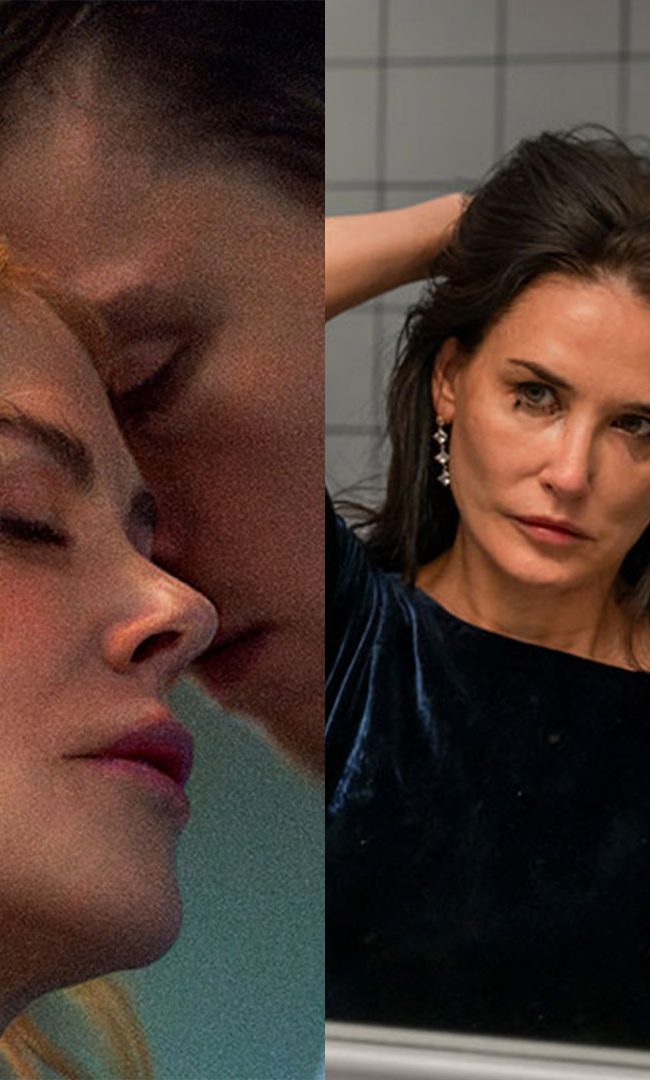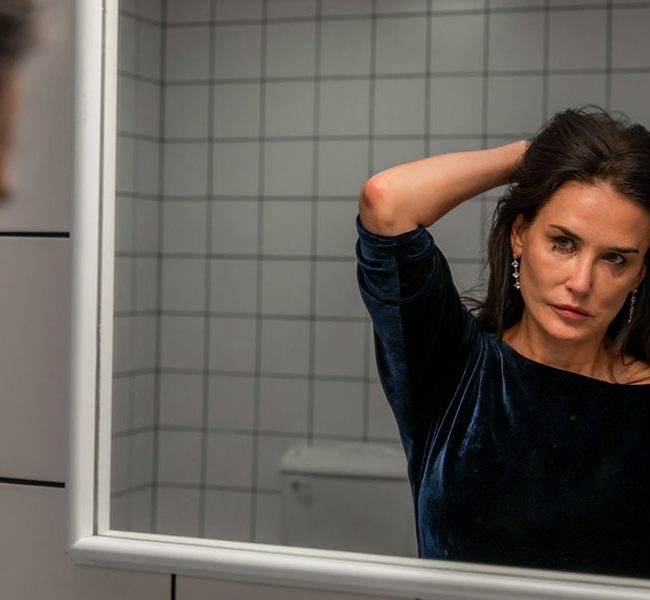A Conversation with Coralie Fargeat (THE SUBSTANCE)
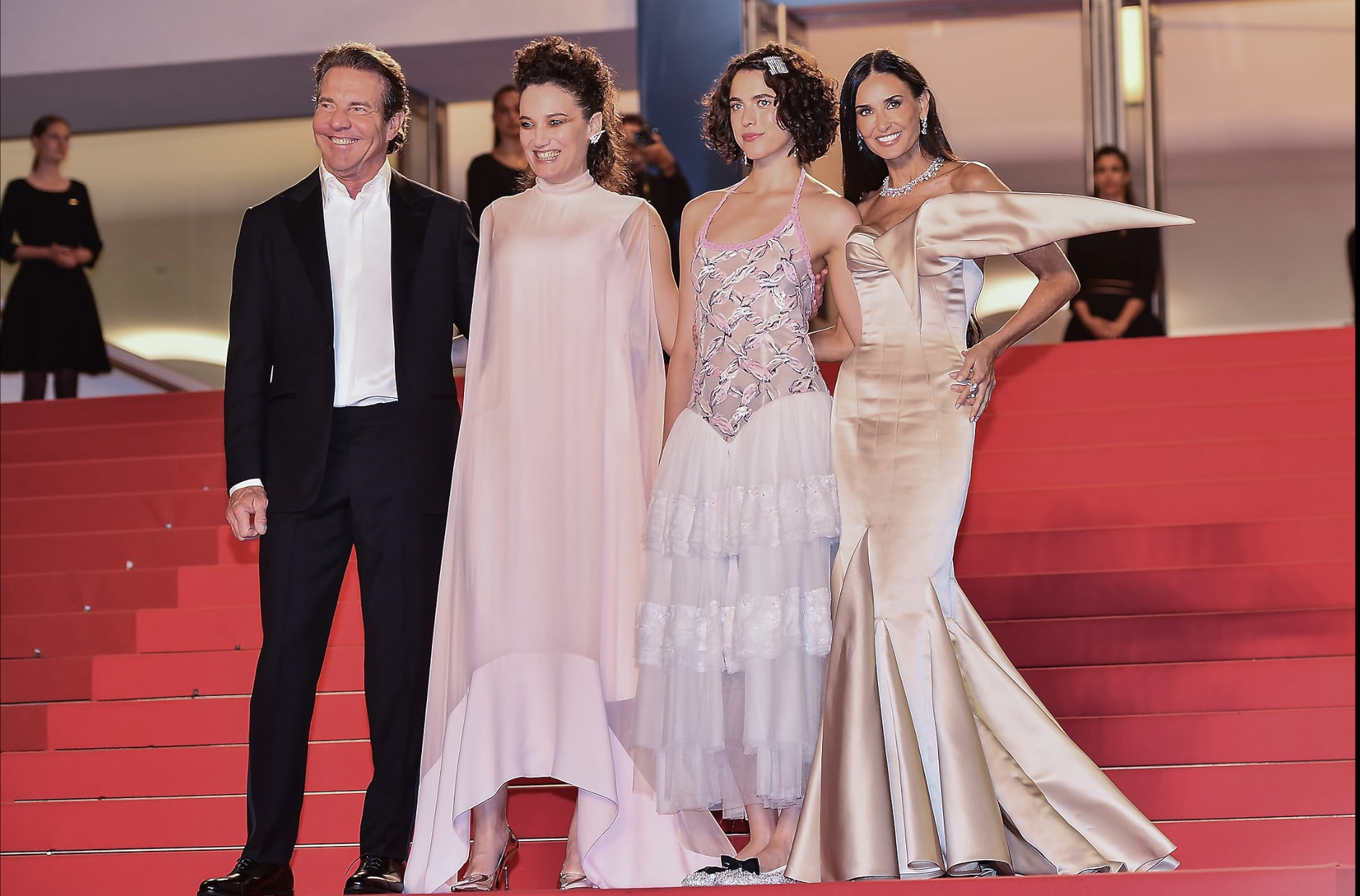
French filmmaker Coralie Fargeat burst onto the international cinema scene with her audacious debut feature, Revenge (2017), a visceral and stylish take on the rape-revenge thriller that subverted genre expectations. Known for her bold visual style and unflinching approach to violence and sexuality, Fargeat quickly established herself as a provocative voice in contemporary cinema. Her work challenges societal norms and gender stereotypes, often exploring themes of female empowerment and the complexities of human nature. With The Substance starring Demi Moore, Margaret Qualley and Dennis Quaid, Fargeat continues to push boundaries and captivate audiences with her unique vision. I barely have the words to describe just how insane this movie is; however, it is easily my favorite of the year. I implore you to see it in a theater ASAP. It was an honor to speak with Coralie in the following conversation edited for length and clarity.
Hammer To Nail: Thank you so much for taking the time to speak with me today. I am so rarely phased by horror films but this one really got me. Basic question to start but I would love to know how Demi Moore, Margaret Qualley and Dennis Quaid wound up in the roles?
Coralie Fargeat: It was a whole process. I knew the casting process would be the toughest one. Everything relies on those characters. There is not much dialogue so they really carried the movie on their shoulders. I knew I needed to cast Elizabeth Sparkle first because she is the one who generates her other self. Demi’s name came on the table and I thought she would never want to do this. I said to my producers, “Of course it would be great! But, I am sure she would never want to do this type of movie.” It did not cost anything to send her the script so we did!
When I heard that she really responded to the script I was immediately super interested and surprised. I thought, “Ok there is potentially something very interesting here. She is really an icon who represents a lot of what the movie is about. The hyper symbolism of living under the public eye and having to care about how your appearance and how your body can define you.
We took a lot of time, Demi and I, to talk before we decided to work together. I really wanted her to understand the exact type of movie I wanted to do, how far I wanted to go, how intense it was going to be, the level of prosthetics, the level of nudity, the visuals, the sound, the fact that we were not a huge Hollywood crew and would be shooting in France in an indie way, etc. I needed her to have all the tools to be sure that she really wanted to join the ship and tell this story.
I discovered somebody who is extremely instinctive, very much risk taking and someone who had a very rock and roll mind in terms of the things she wanted to do at this stage in her life. That was something that I knew was going to change the face of the movie. While I was discussing with Demi I was thinking, “who can be an interesting pairing for her?” When I met with Margaret I felt that they had a common energy. Margaret is also a very raw and instinctive actress. She is very animalistic and physical with her body to create performance. She used to be a dancer. I felt that they would be perfect.
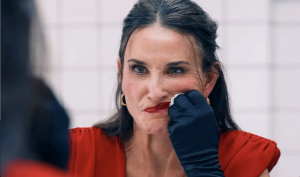
Demi Moore in THE SUBSTANCE
For Dennis, the role was meant to be played by Ray Liotta. I had a great meeting with him and he loved the project. It was a very powerful meeting, unfortunately, He passed away when we started prep. We took a moment to process and try to figure out who can be a great actor to take the role. We sent Dennis the script and he reacted instantly. He loved the project. When he came on set he immediately jumped into the shoes of Harvey. He was eager to discover the entire visual world of the film. He felt that I had a very precise vision and he was so happy to go for it. He completely portrayed the kind of excess and craziness I had in mind for the character. Dennis came onto the project rather quickly. We did not have time to rehearse or do readings. Naturally it worked. He really ate those two kilos of shrimp. He wanted to portray this grossness and lean into the satire of these disgusting behaviors and manners.
HTN: Well all three actors were incredible and perfectly cast. This opening time lapse shot is such a great way to tell the audience everything we need to know about Elizabeth’s career so far. How did this moment come to you and was it the first thing that you wrote?
CF: It came early in the process. I work a lot with symbolism and I am always looking for the best images that are going to present the ideas that I am trying to portray to the audience. I do not write a lot of dialogue. My brain is always researching what image or symbol is going to tell the story in the best way. Having the lead character be a famous actress, I felt was the strongest symbolism of having to deal with the perception of yourself. People will judge you based on how you present yourself or what you look like. The heightened symbolism of that is the Hollywood world which is on everyone’s sub conscious collective mind whether you have been there or not.
We all have an idea of the star and the dream it represents. Being under the spotlight and receiving love. If you are beautiful you will be valued. The first scene I wrote is the birth scene. I remember I had the idea while in the shower. It’s funny, it’s always when I let go and stop trying to think that my imagination puts the pieces together. The idea of the time lapse of the star representing the backstory of Elizabeth would be a perfect way to use my filmic language to open the story. It is specific to my filmic language. It is impactful without one word or having to actually show any kind of back story. This idea resonated very powerfully in me. It was the last sequence we finished in the editing room. It took a long time to make it exactly right.
HTN: It is a perfect opening, and going to this birth sequence that you mentioned, it is truly a magnificent display of body horror and filmmaking magic. How did the idea of another human birthing out of Elizabeth’s back come to you? And what were you and [Cinematographer] Benjamin Kracun hoping to achieve in this moment with the aesthetics?
CF: This was the most important scene of the film for me. It was the first scene that came naturally but it took a long time to write it. When I write I welcome the ideas the way they come, even if they are messy at first. Even if it’s not fully realized yet, but it feels right, I will explore it. I knew it had to be very visceral, organic, and filled with power. I needed to display this metamorphosis in this way because it makes for strong symbolism towards our image and boundaries. Again, I wanted to make something that without one word would be immersive and propel the audience into this story. It’s a big leap and I knew it had to be done in a very intense way so that the audience would have the key to enter this world. Each piece was very important. What I was going to show, what I was going to hide, This light tunnel that transmits their brains it all was so specific.
For all of the scenes where there is no dialogue, I write every element including the shots, the rhythm and the sound. It was the scene that took the most time to prep and shoot. We had to deal with many constraints including prosthetics, fake bodies, creating a real light tunnel, and actual fire shots. We also faced challenges with synchronizing the camera with the POV, filming through a mirror (which I wouldn’t recommend), and even building two separate bathrooms, etc. There was a whole war room in there. It took around two weeks to shoot. The close-ups with the multiple eyes, which are very important, required multiple different cameras. We had many shots we had to stitch together to give the effect of this long sequence where we enter her eyes then come out and discover Sue. So yeah, for me it was one of the greatest scenes I ever crafted. It is the emotional core of the film and the emotional core of the filmmaking. All of the department heads were so involved in this scene. We needed everyone to be very involved to do this.
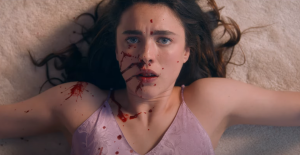
Margaret Qualley in THE SUBSTANCE
HTN: You can really feel how much time and passion was put into that moment! At around the 53 minute is one of the most horrifying in the entire film, but it’s not a violent moment. I am talking about the montage of Margaret leading the new dance routine for Pump it Up. The quick cuts, glossy cinematography and music given the context make for a gut churning moment. What were you going for with this montage?
CF: This montage was really a way to express another kind of violence where hyper-sexualization can become something that devours you. This scene represents how much the outside world can consume our body. How much the world can reduce our bodies into pieces, like a butt or a sexy hip. Sue is playing with this as much as she is a victim of it. It represents how the gaze can chop us up into body parts. Often, that can be our only way to exist. That can be what puts us at the center of attention. For Sue, that is the tool she uses because that is the only one she really knows.
It’s an endless circle. If you put your value into the external gaze, you will always be dependent on staying perfect. She is the victim of a trap that is impossible to escape. Society asks our bodies to not change and to always stay the same. Young, beautiful, sexy, when you are not that, society considers you literally “body horror.” You are erased because you are considered disgusting. Sue sees this as her only way to be seen, valued and at the center of the public space. She uses this hyper-sexualized image to put her at the center of all the eyes.
– Jack Schenker (@YUNGOCUPOTIS)








